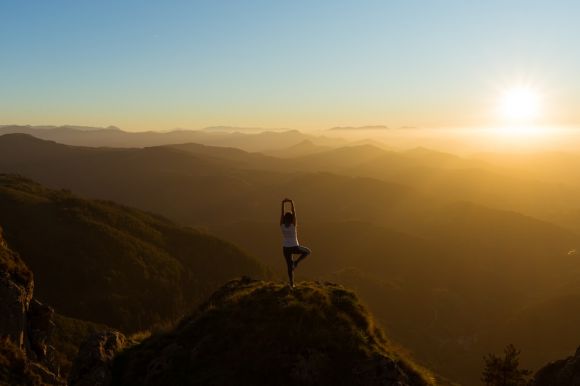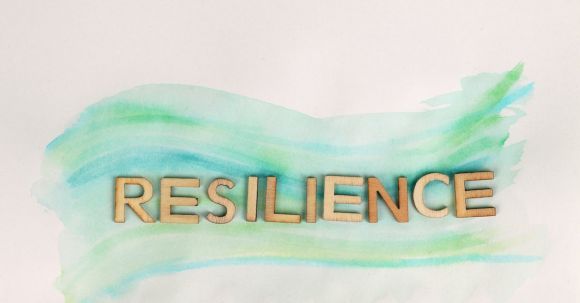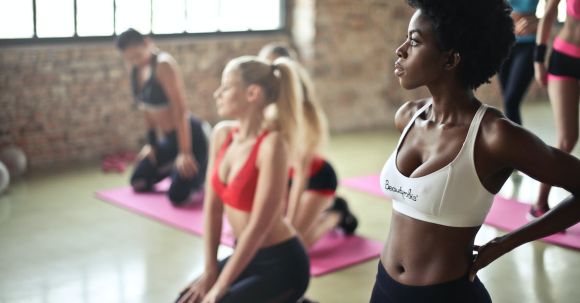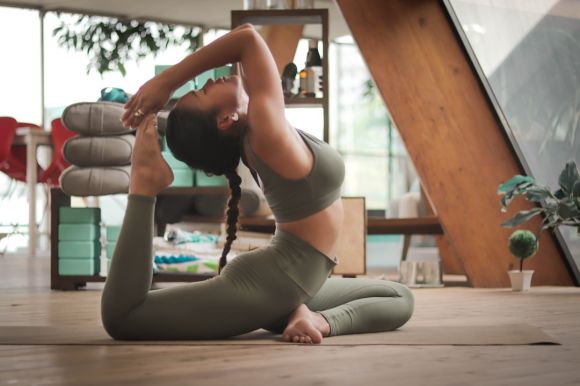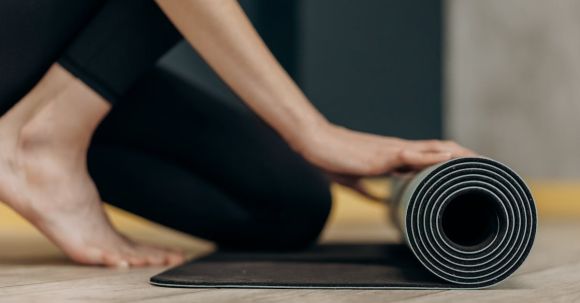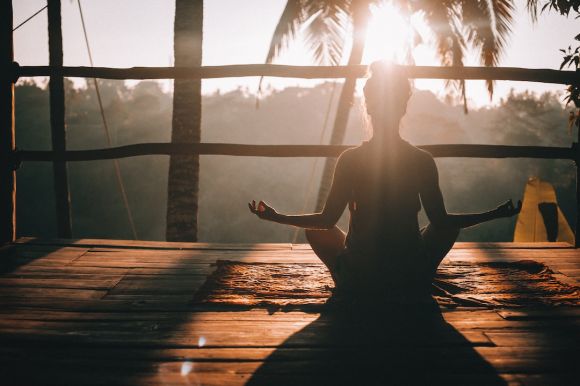In today's fast-paced world, finding time to relax and unwind is essential for maintaining overall well-being. One effective way to achieve this is through the practice of restorative yoga. Restorative yoga is a gentle form of yoga that focuses on relaxation and rejuvenation. By incorporating props and holding poses for extended periods of time, restorative yoga allows the body and mind to fully relax and let go of tension. In this article, we will explore the benefits of restorative yoga and how it can help you find peace and tranquility in your busy life.
Yoga and meditation
In today's fast-paced world, finding balance and harmony in our lives can often feel like an impossible task. The demands of work, family, and daily responsibilities can leave us feeling overwhelmed and disconnected from ourselves. However, there is a powerful practice that can help us find peace amidst the chaos - yoga and meditation.
The Power of Yoga
Yoga is an ancient practice that originated in India thousands of years ago. It combines physical postures, breath control, and meditation to create a holistic approach to wellness. The physical aspect of yoga, known as asanas, helps to strengthen the body, increase flexibility, and improve posture. But yoga is not just about the physical. It also has a profound effect on our mental and emotional well-being. Through the practice of yoga, we learn to quiet the mind and focus on the present moment. This helps to reduce stress and anxiety, allowing us to find a sense of calm and peace within ourselves. By connecting with our breath and moving our bodies in a mindful way, we can release tension and negative energy, creating space for positive thoughts and emotions to arise.The Benefits of Meditation
Meditation is another powerful tool for achieving balance and harmony in our lives. It involves sitting in a comfortable position and focusing our attention inward. Through meditation, we can cultivate a deep sense of awareness and presence. Regular meditation practice has been shown to reduce stress, improve concentration, and enhance overall well-being. It allows us to observe our thoughts and emotions without judgment, giving us a greater sense of control over our minds. By practicing meditation, we can develop a sense of inner peace and tranquility that extends into all aspects of our lives.Finding Your Balance
To achieve balance and harmony through yoga and meditation, it is important to establish a regular practice. This can be as little as 10 minutes a day, but consistency is key. Set aside a specific time and space for your practice, free from distractions. Create a peaceful environment by lighting candles, playing soft music, or incorporating essential oils into your routine. Start with a gentle yoga sequence to warm up your body and prepare your mind for meditation. Focus on your breath as you move through the poses, allowing yourself to be fully present in each moment. After your yoga practice, find a comfortable seated position and begin your meditation. Close your eyes and bring your attention to your breath, allowing any thoughts or distractions to simply pass by without judgment. As you continue to practice yoga and meditation, you will begin to notice a shift in your mindset and overall well-being. You will feel more centered and grounded, better able to handle the challenges that life throws your way. You will cultivate a sense of inner peace and harmony that radiates outwards, positively impacting your relationships, work, and daily interactions. In conclusion, yoga and meditation are powerful tools for achieving balance and harmony in our lives. By incorporating these practices into our daily routine, we can find a sense of peace amidst the chaos of modern life. So, take a moment to unroll your yoga mat, find a quiet space, and connect with yourself through the transformative power of yoga and meditation.
In today's fast-paced and demanding world, cultivating patience and resilience has become more important than ever. The constant pressure to achieve, the never-ending stream of distractions, and the challenges of daily life can easily overwhelm us. However, by incorporating yoga and meditation into our daily routine, we can develop the qualities of patience and resilience that will help us navigate through life's ups and downs with grace and ease.
The Power of Yoga
Yoga is a holistic practice that combines physical postures, breathing exercises, and meditation to create a sense of balance and harmony in the body and mind. It is not just a physical workout but also a mental and spiritual discipline that helps us connect with our inner selves and find inner peace. Through the practice of yoga, we learn to slow down and be present in the moment. We become aware of our breath and our body, allowing us to let go of the stress and tension that often accompany our busy lives. As we move through the different poses, we learn to be patient with ourselves, accepting where we are in our practice and honoring our bodies' limits. This cultivates a sense of patience that extends beyond the yoga mat and into our daily lives. Yoga also teaches us resilience. As we hold challenging poses, we learn to stay calm and focused even when faced with discomfort or difficulty. We learn to breathe through the challenges, trusting that we have the strength and inner resources to overcome them. This builds resilience, the ability to bounce back from setbacks and face adversity with courage and determination.The Benefits of Meditation
Meditation is another powerful tool for developing patience and resilience. By sitting in stillness and observing our thoughts and emotions without judgment, we learn to cultivate a sense of detachment from the ups and downs of life. We become less reactive and more responsive, able to navigate through difficult situations with clarity and composure. Through regular meditation practice, we learn to quiet the mind and find inner peace. This allows us to tap into our inner wisdom and intuition, helping us make better decisions and navigate life's challenges with grace and ease. We become less easily swayed by external circumstances and more anchored in our own inner truth.Practical Tips for Cultivating Patience and Resilience
Incorporating yoga and meditation into our daily routine is a powerful way to develop patience and resilience. Here are some practical tips to get started: 1. Start with small steps: Begin by setting aside just a few minutes each day for yoga and meditation. Gradually increase the duration as you become more comfortable with the practice. 2. Find a style that resonates with you: There are many different styles of yoga and meditation, so explore and find one that suits your needs and preferences. Whether it's gentle yoga, power yoga, mindfulness meditation, or loving-kindness meditation, find what resonates with you and stick with it. 3. Create a dedicated space: Set up a dedicated space in your home where you can practice yoga and meditation. Make it a calm and peaceful environment that invites you to relax and let go. 4. Be consistent: Consistency is key when it comes to developing a yoga and meditation practice. Aim to practice at the same time each day to establish a routine and make it a habit. 5. Be patient with yourself: Remember that developing patience and resilience is a journey, and it takes time and practice. Be patient with yourself and trust the process. Embrace the ups and downs, knowing that each challenge is an opportunity for growth.Conclusion
In a world that often values speed and instant gratification, developing patience and resilience is a powerful antidote to the stress and overwhelm of daily life. By incorporating yoga and meditation into our routine, we can cultivate these qualities and navigate through life's challenges with grace and ease. So, take a deep breath, roll out your yoga mat, and embark on a journey of self-discovery and personal growth. The rewards are well worth the effort.
Yoga has gained immense popularity in recent years, and for good reason. It is not just a physical exercise but also a holistic practice that combines movement, breath, and meditation. One of the key benefits of yoga is its ability to increase body awareness and mindfulness. In this article, we will explore how yoga can help you cultivate these qualities and enhance your overall well-being.
Understanding Body Awareness
Body awareness refers to the ability to tune into the sensations and movements of your body. It involves being present in the moment and paying attention to how your body feels, without judgment or criticism. Unfortunately, many of us lead busy lives that disconnect us from our bodies. We may be so caught up in our thoughts and worries that we forget to listen to what our bodies are telling us.Yoga as a Path to Body Awareness
Yoga provides a wonderful opportunity to reconnect with our bodies and develop a deeper sense of body awareness. Through the practice of yoga poses, also known as asanas, we learn to observe the sensations in our bodies and become more attuned to our physical and emotional states. As we move through different poses, we are encouraged to pay attention to our breath, the alignment of our bodies, and any areas of tension or discomfort. By cultivating body awareness through yoga, we can learn to listen to our bodies and respond to their needs. This can help prevent injuries and promote better overall health. When we are aware of how our bodies feel, we can make conscious choices about how to move and what to eat, leading to a more balanced and mindful lifestyle.Developing Mindfulness
Mindfulness, on the other hand, is the practice of being fully present and engaged in the present moment. It involves paying attention to our thoughts, feelings, and physical sensations without judgment. Mindfulness allows us to observe our experiences without getting caught up in them or reacting impulsively. It helps us develop a sense of clarity, calmness, and acceptance.Yoga as a Path to Mindfulness
Yoga and mindfulness go hand in hand. As we practice yoga, we are encouraged to bring our attention to the present moment and let go of distractions. By focusing on our breath and the sensations in our bodies, we can cultivate a sense of mindfulness throughout our practice. This can extend beyond the mat and into our daily lives, helping us navigate challenges with greater ease and grace. Yoga also incorporates meditation, which is a powerful tool for developing mindfulness. During meditation, we sit in stillness and observe our thoughts and emotions without getting attached to them. This practice helps to quiet the mind and create space for clarity and insight. By integrating meditation into our yoga practice, we can deepen our mindfulness and experience a greater sense of peace and presence. In conclusion, yoga offers a transformative journey towards increased body awareness and mindfulness. Through the practice of yoga poses and meditation, we can reconnect with our bodies, observe our experiences without judgment, and cultivate a sense of clarity and presence. By incorporating yoga into our lives, we can enhance our overall well-being and live with greater awareness and intention. So, roll out your mat and begin your journey towards a more mindful and embodied life through the practice of yoga.
Yoga has become increasingly popular over the years, with people from all walks of life embracing this ancient practice. Whether you're a beginner or an experienced yogi, finding the perfect yoga class that suits your needs can make all the difference in your practice. With so many options available, it can be overwhelming to know where to start. In this article, we will explore some tips to help you find the perfect yoga class for your needs.
Identify your goals and preferences
Before you begin your search for the perfect yoga class, it's important to identify your goals and preferences. Are you looking to improve your flexibility, reduce stress, or build strength? Do you prefer a fast-paced, dynamic practice or a slow, gentle one? Understanding what you hope to achieve and what type of practice resonates with you will guide you in finding the right class.Research different styles of yoga
Yoga is not a one-size-fits-all practice. There are various styles of yoga, each with its own unique approach and benefits. Some popular styles include Hatha, Vinyasa, Ashtanga, and Bikram. Take the time to research and understand the different styles to determine which one aligns with your goals and preferences.Look for qualified instructors
The quality of instruction can greatly impact your yoga experience. Look for classes taught by qualified instructors who have completed a reputable yoga teacher training program. Check their credentials and certifications to ensure they have the necessary knowledge and expertise to guide you safely through your practice.Consider the class level and intensity
Yoga classes are often categorized by level, ranging from beginner to advanced. It's important to choose a class that matches your current skill level. Starting with a class that is too advanced can leave you feeling overwhelmed and discouraged, while a class that is too easy may not challenge you enough. Additionally, consider the intensity of the class. Some classes may focus more on relaxation and stretching, while others may be more physically demanding. Be honest with yourself about what you are looking for and choose a class that suits your needs.Take advantage of trial classes and introductory offers
Many yoga studios offer trial classes or introductory offers for new students. This is a great opportunity to try out different classes and instructors without committing to a long-term membership. Take advantage of these offers to get a feel for the studio, the instructor, and the style of yoga being taught. This will help you determine if it's the right fit for you.Consider the location and schedule
Finding a yoga class that fits into your schedule and is conveniently located can make it easier to commit to a regular practice. Consider the proximity of the studio to your home or workplace and the class schedule to ensure that it aligns with your availability. Remember, consistency is key in establishing a yoga practice.Listen to recommendations and read reviews
Word of mouth can be a valuable resource when searching for the perfect yoga class. Ask friends, family, or colleagues who practice yoga for their recommendations. Additionally, read online reviews and testimonials to get a sense of other students' experiences. While everyone's preferences may differ, hearing about others' positive experiences can help steer you in the right direction. Conclusion: Finding the perfect yoga class for your needs may require some exploration and trial and error. By identifying your goals, researching different styles, considering the class level and intensity, and taking advantage of trial classes and introductory offers, you can find a class that suits your needs and enhances your yoga journey. Remember, the most important thing is to listen to your body and choose a practice that brings you joy and fulfillment. Happy yoga searching!
Are you looking to transform your body and achieve a toned, flexible physique? Look no further than power yoga. This dynamic and challenging form of yoga has gained popularity in recent years for its ability to not only improve physical fitness but also promote mental well-being. In this article, we will explore the benefits of power yoga and how it can help you achieve your fitness goals.
Building Strength and Stamina
One of the key aspects of power yoga is its emphasis on building strength and stamina. Unlike traditional yoga practices that focus on slower movements and static poses, power yoga incorporates dynamic movements that target multiple muscle groups simultaneously. This helps to increase overall strength and endurance, making it an excellent workout for those looking to tone their bodies.Improving Flexibility and Balance
In addition to building strength, power yoga also helps to improve flexibility and balance. The flowing sequences and challenging poses require a great deal of flexibility, helping to stretch and lengthen your muscles. Regular practice of power yoga can gradually increase your range of motion and improve your overall flexibility. Additionally, the focus on balance in power yoga helps to enhance stability and coordination, leading to better posture and body control.Enhancing Cardiovascular Health
Power yoga is not only beneficial for building strength and flexibility but also for improving cardiovascular health. The fast-paced, continuous movements of power yoga raise your heart rate and increase blood circulation, providing a cardiovascular workout similar to a traditional aerobic exercise. This helps to strengthen your heart, improve lung capacity, and boost overall cardiovascular fitness.Burning Calories and Losing Weight
If you're looking to shed some pounds and burn calories, power yoga can be a valuable addition to your fitness routine. With its combination of strength, flexibility, and cardiovascular components, power yoga is an effective calorie-burning workout. A one-hour session of power yoga can burn anywhere from 300-600 calories, depending on your intensity level. Regular practice of power yoga, coupled with a balanced diet, can contribute to healthy and sustainable weight loss.Reducing Stress and Promoting Mental Well-being
In addition to its physical benefits, power yoga is known for its ability to reduce stress and promote mental well-being. The focus on deep breathing and mindfulness during power yoga helps to calm the mind and release tension. The physical exertion of power yoga also stimulates the release of endorphins, the body's natural feel-good hormones, which can improve mood and reduce feelings of anxiety and depression.Creating a Mind-Body Connection
Power yoga is not just a physical workout; it is also a practice that cultivates a strong mind-body connection. As you flow through the sequences and hold challenging poses, you become more aware of your body and its capabilities. This increased self-awareness can extend beyond the yoga mat, leading to improved body awareness and mindfulness in your everyday life. In conclusion, power yoga is a transformative practice that can help you achieve a toned, flexible body while promoting mental well-being. By incorporating dynamic movements, challenging poses, and deep breathing, power yoga builds strength, improves flexibility, enhances cardiovascular health, burns calories, reduces stress, and creates a powerful mind-body connection. Whether you're a beginner or an experienced yogi, power yoga can be adapted to suit your fitness level and goals. So why wait? Step onto your mat and start transforming your body with power yoga today.
Emotional blockages can have a significant impact on our overall well-being and quality of life. These blockages can manifest as unresolved traumas, negative thought patterns, or suppressed emotions. They can prevent us from experiencing true emotional healing and hinder our personal growth. However, through the practice of meditation, we can begin to release these blockages and find a path towards emotional healing.
Understanding Emotional Blockages
Emotional blockages are barriers that prevent us from fully expressing and processing our emotions. These blockages can be caused by past traumatic experiences, societal conditioning, or even self-imposed limitations. When these blockages are present, it can result in a range of emotional issues, such as anxiety, depression, or anger.Meditation as a Tool for Release
Meditation is a powerful tool that can help us release emotional blockages and find emotional healing. By creating a space of stillness and inner awareness, meditation allows us to observe and acknowledge our emotions without judgment or resistance. Through regular practice, we can begin to unravel the layers of emotional blockages and release them from our being.Cultivating Mindfulness
Mindfulness is a key component of meditation that allows us to become aware of our thoughts, emotions, and sensations in the present moment. By cultivating mindfulness, we can develop a deeper understanding of our emotional blockages and their underlying causes. This awareness enables us to address these blockages directly and begin the process of healing.Breathing into Emotions
One technique often used in meditation is to focus on the breath. By bringing our attention to the breath and consciously breathing into our emotions, we can create space for these emotions to arise and be released. As we breathe into our emotions, we allow ourselves to fully experience them without judgment or resistance. This process can be incredibly healing and transformative.Letting Go of Attachments
Emotional blockages often stem from attachments and clinging to certain emotions or experiences. Through meditation, we can learn to let go of these attachments and cultivate a sense of detachment. By observing our emotions without clinging or aversion, we can begin to release the blockages that are holding us back.Connecting with Self-Compassion
Self-compassion is a vital aspect of emotional healing. Through meditation, we can develop a greater sense of self-compassion by cultivating kindness and understanding towards ourselves. By acknowledging our pain and suffering without judgment, we create a safe space for emotional healing to occur.Finding Support and Guidance
While meditation can be a powerful tool for emotional healing, it is essential to seek support and guidance when needed. Engaging in therapy or seeking the assistance of a meditation teacher can provide additional insights and techniques to aid in the release of emotional blockages.Embracing the Journey of Emotional Healing
Emotional healing is not a linear process but rather a journey of self-discovery and growth. Through the practice of meditation, we can begin to release emotional blockages and find a path towards healing. By cultivating mindfulness, breathing into emotions, letting go of attachments, and connecting with self-compassion, we create space for emotional healing to occur.Conclusion: Embracing Emotional Healing through Meditation
Emotional blockages can be deeply ingrained within us, but through the practice of meditation, we can begin to release these blockages and find emotional healing. By cultivating mindfulness, breathing into our emotions, letting go of attachments, and connecting with self-compassion, we create a safe space for emotional healing to occur. Remember, emotional healing is a journey, and it requires patience, self-compassion, and support. Through meditation, we can embark on this journey and find the peace and healing we seek.
In today's fast-paced world, finding inner stillness and calmness can be a challenge. With endless distractions and constant stimulation, our minds often become overwhelmed and restless. However, through the practice of yoga, we can learn to calm our minds and find that much-needed inner stillness. In this article, we will explore how yoga can help us achieve a sense of calmness and tranquility.
Understanding the Mind-Body Connection
Before diving into the world of yoga, it's important to understand the mind-body connection. Our minds and bodies are intricately linked, and what affects one will undoubtedly affect the other. When our minds are cluttered and restless, our bodies can become tense and agitated. On the other hand, when we find peace and stillness in our minds, our bodies can relax and find balance.The Power of Breath
One of the fundamental aspects of yoga is breath control. The breath is a powerful tool that can help us calm our minds and find inner stillness. Through deep, conscious breathing, we can activate the body's relaxation response, reducing stress and anxiety. Practicing deep breathing techniques during yoga helps to anchor our attention to the present moment, allowing the mind to quieten and find peace.Finding Focus through Asanas
Asanas, or yoga postures, are another key element in calming the mind. By practicing various yoga poses, we can bring our attention to the physical sensations in our bodies, helping to shift our focus away from the constant stream of thoughts. Asanas provide an opportunity to cultivate mindfulness, as we become fully present in the movement and alignment of our bodies. Through this focused attention, the mind can settle into a state of stillness.Meditation and Mindfulness
Yoga and meditation go hand in hand when it comes to calming the mind. Meditation is the practice of training the mind to focus and redirect our thoughts. By incorporating meditation into our yoga practice, we can deepen our ability to find inner stillness. Mindfulness meditation, in particular, encourages us to observe our thoughts and emotions without judgment, allowing them to come and go without attachment. This practice can help us develop a sense of inner calmness and detachment from the constant mental chatter.Creating a Sacred Space
To fully embrace the calming effects of yoga, it's essential to create a sacred space for practice. Find a quiet corner in your home or outdoors where you can dedicate time to your yoga practice. Declutter the space, light candles or incense, and play soft, soothing music if desired. By creating a serene environment, you are setting the stage for a calm and peaceful mind.Embracing a Regular Yoga Practice
Consistency is key when it comes to reaping the benefits of yoga. To truly calm your mind and find inner stillness, it's important to make yoga a regular part of your routine. Set aside dedicated time each day, even if it's just a few minutes, to practice yoga. Over time, you will notice the cumulative effects of your practice, as your mind becomes more at ease and your ability to find inner stillness deepens.Conclusion: Discovering the Power of Yoga
In a world that often feels chaotic and overwhelming, finding inner stillness and calmness is a precious gift. Through the practice of yoga, we can cultivate a peaceful mind and find a sense of tranquility amidst the noise. By embracing the mind-body connection, harnessing the power of breath, practicing asanas, and incorporating meditation and mindfulness, we can calm our minds and discover the transformative power of yoga. So, take a deep breath, roll out your yoga mat, and embark on a journey towards inner stillness and peace.
The immune system plays a crucial role in keeping us healthy by protecting our bodies from harmful pathogens and diseases. With the ongoing pandemic and the constant threat of viruses, it has become more important than ever to strengthen our immune system. While there are various ways to boost immunity, one effective and holistic approach is through the practice of yoga and meditation. In this article, we will explore how yoga and meditation can strengthen your immune system and improve your overall well-being.
Reducing Stress and Boosting Immunity
Chronic stress can weaken the immune system, making us more susceptible to illnesses. Fortunately, yoga and meditation are powerful tools in combating stress. The deep breathing techniques employed in yoga help activate the relaxation response, reducing the production of stress hormones like cortisol. Meditation, on the other hand, allows us to quiet our minds and find inner peace. By regularly practicing yoga and meditation, we can manage stress more effectively, which in turn strengthens our immune system.Enhancing Respiratory Function
Respiratory health is of utmost importance, especially during a respiratory virus outbreak. Yoga and meditation can significantly improve lung function and enhance the respiratory system. Deep breathing exercises in yoga help increase lung capacity and improve oxygen intake. This not only strengthens the lungs but also increases the efficiency of the immune system. Additionally, meditation practices like alternate nostril breathing can clear the nasal passages and prevent respiratory infections.Boosting Blood Circulation
A healthy immune system relies on good blood circulation to transport nutrients, oxygen, and immune cells throughout the body. Yoga poses and meditation techniques stimulate blood flow, improving circulation and enhancing the functioning of the immune system. Poses like the downward dog, headstand, and shoulder stand promote blood circulation to vital organs, ensuring that they receive a sufficient supply of nutrients and oxygen. Meditation, with its focus on relaxation and deep breathing, also helps improve blood circulation.Stimulating the Lymphatic System
The lymphatic system is responsible for removing toxins, waste, and pathogens from the body. However, unlike the cardiovascular system, the lymphatic system does not have a pump to facilitate circulation. Yoga poses that involve twisting, bending, and stretching help stimulate the lymphatic system, aiding in the elimination of toxins and boosting the immune response. Practices like the seated twist, cobra pose, and bridge pose are particularly effective in this regard.Promoting Mind-Body Connection
Yoga and meditation are not just physical practices; they also cultivate a strong mind-body connection. This connection is vital for overall well-being and plays a crucial role in maintaining a healthy immune system. By practicing yoga and meditation, we become more attuned to our bodies, allowing us to listen to its needs and respond accordingly. This self-awareness enables us to make healthier choices in terms of nutrition, sleep, and lifestyle, all of which contribute to a strong immune system.Incorporating Yoga and Meditation Into Your Routine
To reap the benefits of yoga and meditation, it is essential to make them a part of your daily routine. Start by setting aside a specific time each day for your practice. Begin with simple yoga poses and gradually increase the duration and intensity as you progress. Explore different meditation techniques and find the one that resonates with you the most. Remember, consistency is key when it comes to strengthening your immune system with yoga and meditation. In conclusion, yoga and meditation offer a holistic approach to strengthening the immune system. By reducing stress, enhancing respiratory function, boosting blood circulation, stimulating the lymphatic system, and promoting the mind-body connection, these practices contribute to overall well-being and immunity. Incorporating yoga and meditation into your daily routine can be a powerful tool in maintaining good health, especially during these challenging times. So, roll out your yoga mat, find a quiet spot, and embark on a journey towards a stronger immune system and a healthier life.
Are you tired of tossing and turning at night, unable to fall asleep? Do you find yourself waking up multiple times during the night, feeling restless and unable to get back to sleep? If so, you're not alone. Insomnia affects millions of people worldwide, making it difficult to function during the day and negatively impacting overall well-being. While there are various remedies and medications available, one effective and natural solution to overcome insomnia is through meditation exercises. In this article, we will explore how meditation can help you sleep better and provide you with practical exercises to incorporate into your daily routine.
